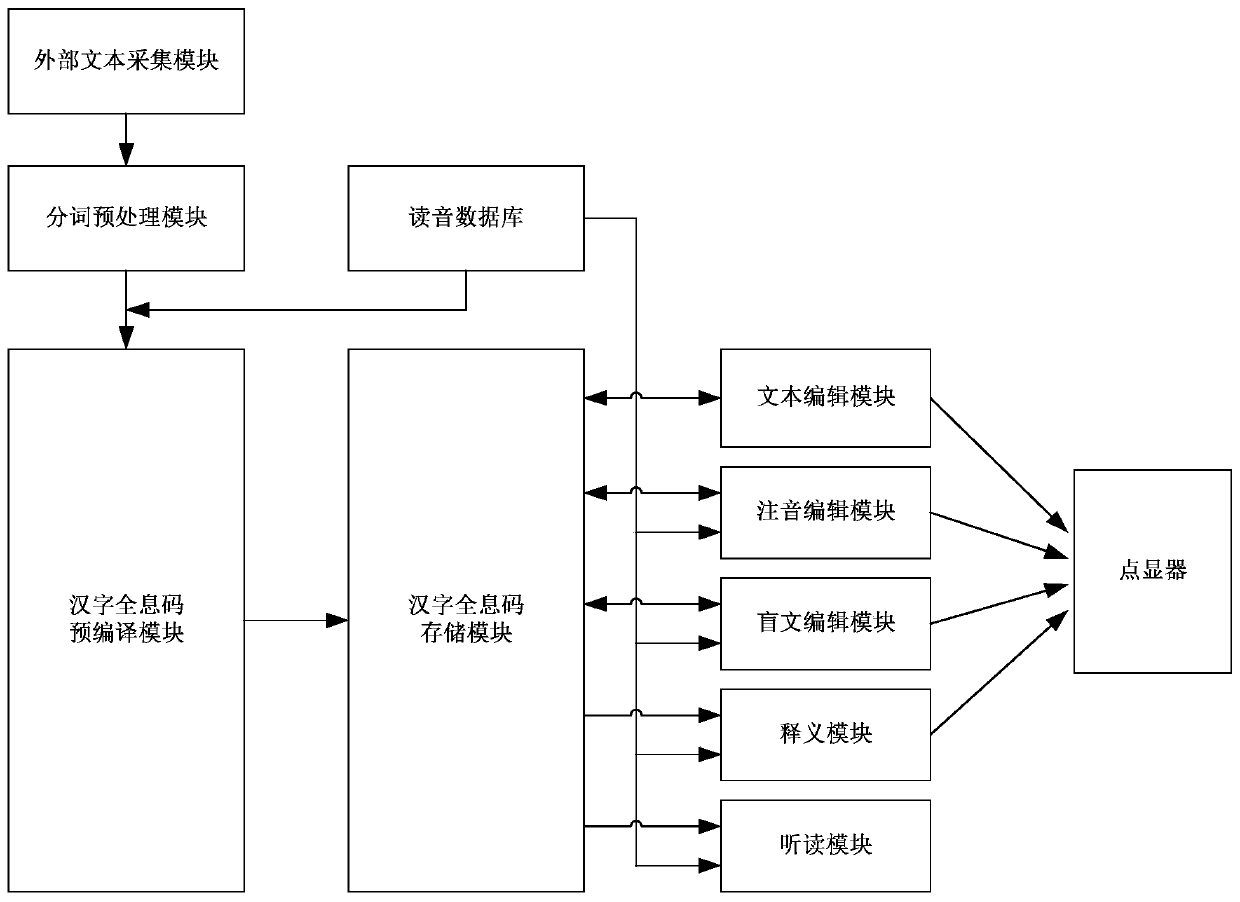A Braille Conversion System Based on New Chinese Character Holographic Coding Rules
A technology for converting systems and Chinese characters, applied in digital data processing, instruments, calculations, etc., can solve problems such as misunderstanding, blind people's incomprehensible reading, and the inability to uniquely determine the meaning of words, so as to achieve the effect of ensuring accuracy
- Summary
- Abstract
- Description
- Claims
- Application Information
AI Technical Summary
Problems solved by technology
Method used
Image
Examples
example 1
[0074] Big (" big " of size), is polyphonic character, has two pronunciations, da4 and dai4, and da4 is the 1st pronunciation, so its holographic Chinese character code=big internal code adds OX1+OX1, wherein 16 of the 3rd byte The base number OX1 is the prompt code for continuous reading and polyphonic characters, because the last digit is "1", which means that it is a polyphonic character, and the pronunciation will be specified by the 4th byte; the 4th byte is OX1, corresponding to 1 in decimal , indicating that the word reads the first pronunciation, that is, the pronunciation da4 with the highest frequency. Because the next last bit of the 3rd byte OX1 is zero, it means that it does not form participle with the following Chinese characters.
[0075] In addition, the size is large, because the pronunciation is the first pronunciation, the 4th byte OX1 of its holographic Chinese character code can be omitted; because it is not participle with the following words and the 4th...
example 2
[0078] Rich: it is a monophonic word, and has only one pronunciation fu4, so its complete holographic Chinese character code=rich inner code+OX1+OX1.
[0079] Because it is a monophonic character, it can also be abbreviated as: rich internal code + OX1;
[0080] When not forming a word with the following words, its 3rd byte is OX1, which can be further simplified this moment: rich holographic Chinese character code=rich inner code.
[0081] Let's look at the Chinese character holographic Chinese character code in the phrase state:
[0082] Hobbies: Love is a monosyllabic word, and it forms a participle with the following words; Hao is a polyphonic character, the first pronunciation is "hao3", and the second pronunciation is "hao4".
[0083]The inner sign indicating number+OX2 of the holographic Chinese character sign indicating number of hobby=love (equivalent to binary 10, and the last position is zero, and expression is a monosyllabic word, and the second last position is 1...
example 3
[0085] Jilin Province: Ji and Lin are monophonic characters and the province is polyphonic, but the first pronunciation (sheng3) is pronounced.
[0086] Therefore, the inner code+OX2 of the holographic Chinese character code of Jilin Province=Ji (single-syllable word, form participle with the back word)+Lin's inner code+OX2+province inner code+OX1+OX1, obviously, the last 2 bytes of the province can be omitted.
PUM
 Login to View More
Login to View More Abstract
Description
Claims
Application Information
 Login to View More
Login to View More - R&D
- Intellectual Property
- Life Sciences
- Materials
- Tech Scout
- Unparalleled Data Quality
- Higher Quality Content
- 60% Fewer Hallucinations
Browse by: Latest US Patents, China's latest patents, Technical Efficacy Thesaurus, Application Domain, Technology Topic, Popular Technical Reports.
© 2025 PatSnap. All rights reserved.Legal|Privacy policy|Modern Slavery Act Transparency Statement|Sitemap|About US| Contact US: help@patsnap.com

